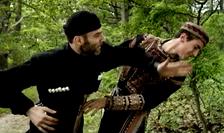|
Khridoli is an ancient
Georgian martial art.Since the 1980s, several groups initiated a revival of
Georgian martial arts from various sources, including practical study and
folk memory. In 1989, a Georgian Martial Arts Department was created at the
Rustaveli Society. Later in 1990, the Federation of Georgian Martial Arts -
Khridoli was formed and named. |
 |
|
For centuries, Georgia's
ability to ward off invaders was due largely to its culture of encouraging
martial arts. Georgia was able to endure whole eras in which other numerous
countries, both small and large, vanished without a trace. In the course of
3500 years, Georgian warriors successfully withstood enemies attacking the
kingdoms of Georgia and were later able to unite the Georgian kingdom.
Until the beginning of 20th century, every
region of Georgia held competitions in martial arts and in other sports
similar to the ancient Olympic games. The competitions used to be held like
military maneuvers in which several thousand men fought by the rules of
Saldasti (a special boxing style with additional use of swords and other
combat weapon made from wood).
Diversity and multiform features of fighting styles practised in various
regions of Georgia had crucial influences on the formation of Georgian
Martial arts and its rich culture. Each part of Georgia had its unique
military traditions. More than 30 styles of wrestling and boxing have been
practiced in Georgia, as well as a wide range of armaments and combat rules.
Along with a rich tradition in martial arts, Georgians also possessed a
“Warrior Code” that consisted of 365 rules.Due to the need for constant
military vigil, these rules were in effect throughout Georgia and actually
contributed to the code of conduct and way of life for all Georgians.
Unfortunately, in the 14th century, traditions of Georgian martial arts were
under serious threat of extinction. After the beginning of the Russian
occupation, the empire repressed all aspects of Georgian cultural heritage,
and especially military traditions. Moreover, after the second occupation in
1921, Georgian martial arts along with the whole Georgian State submitted to
the control of Russian Bolsheviks.
Georgian wrestling and boxing was a major contributing factor for the
creation of the Russian Sambo. Throughout the course of 70 years, the
practice of Georgian martial arts was strictly banned. |













